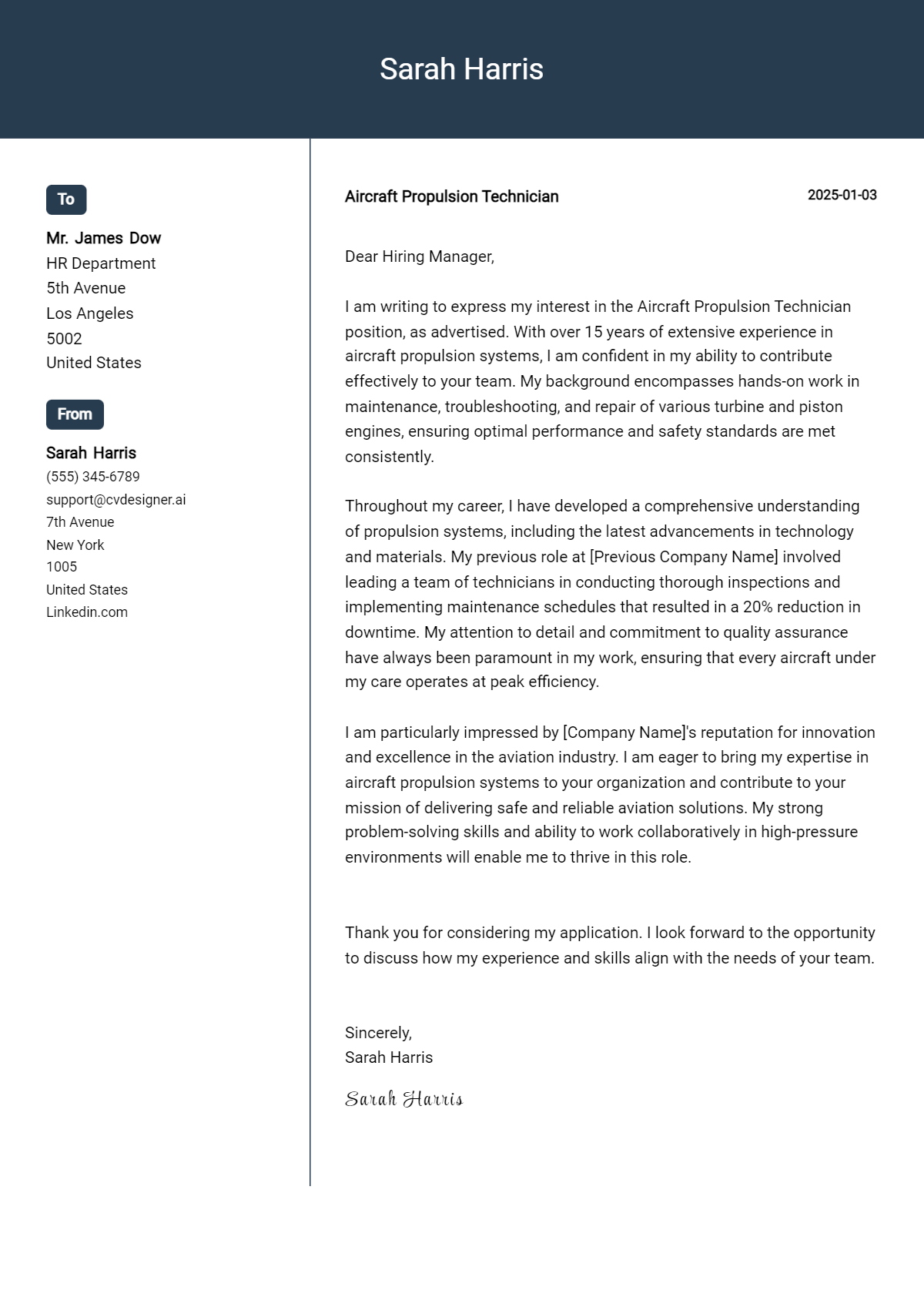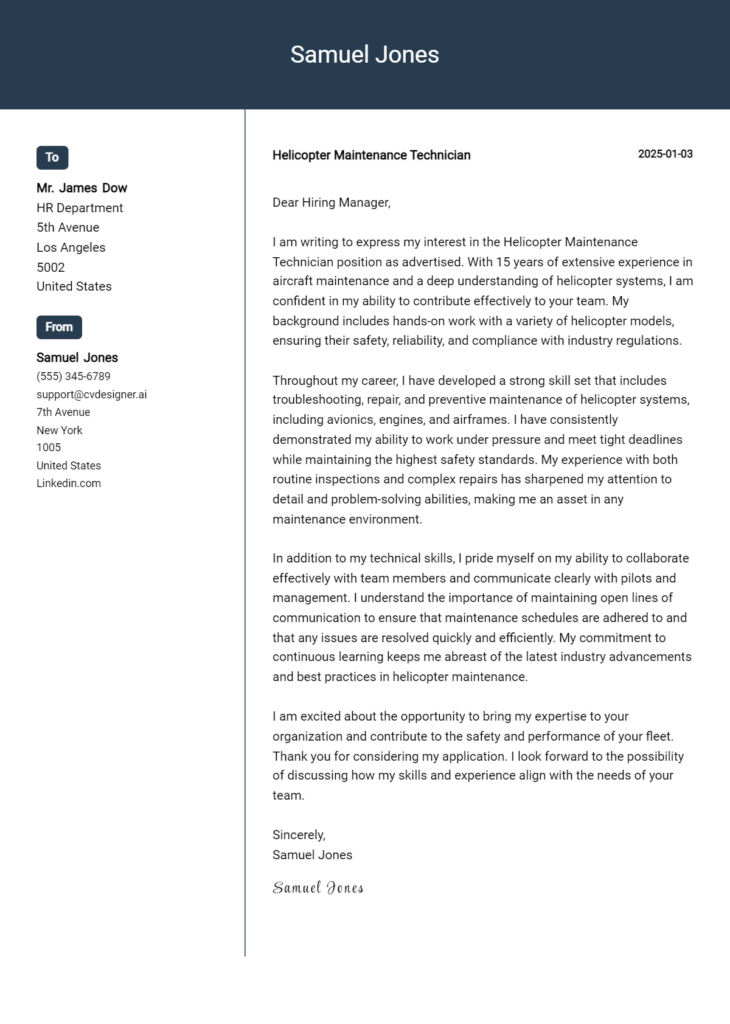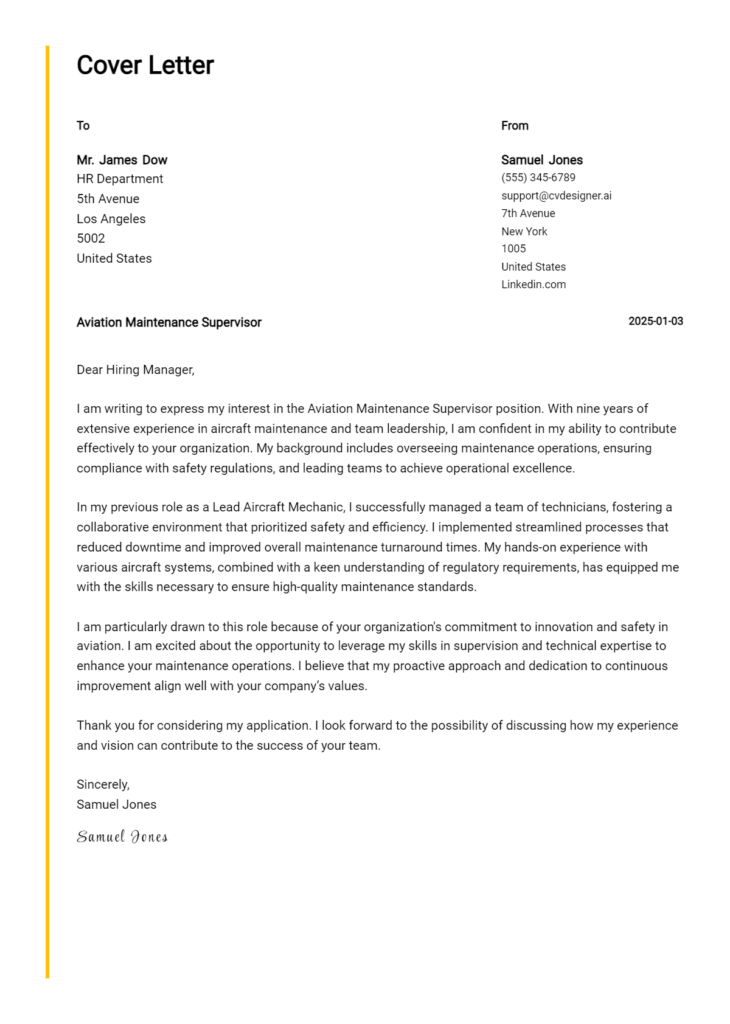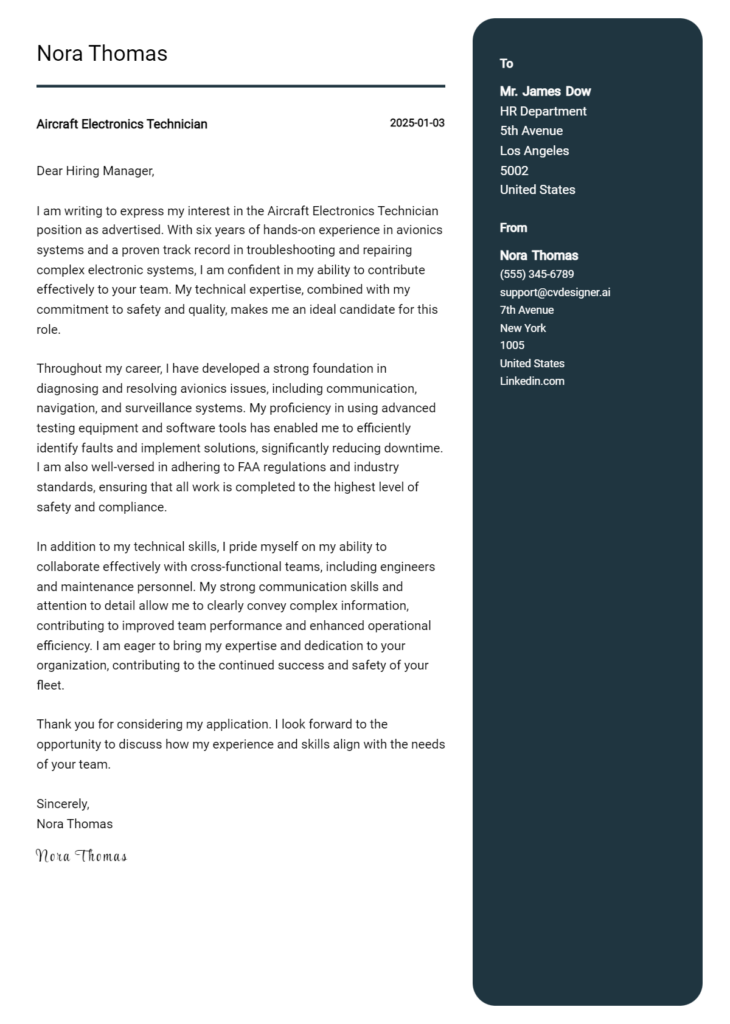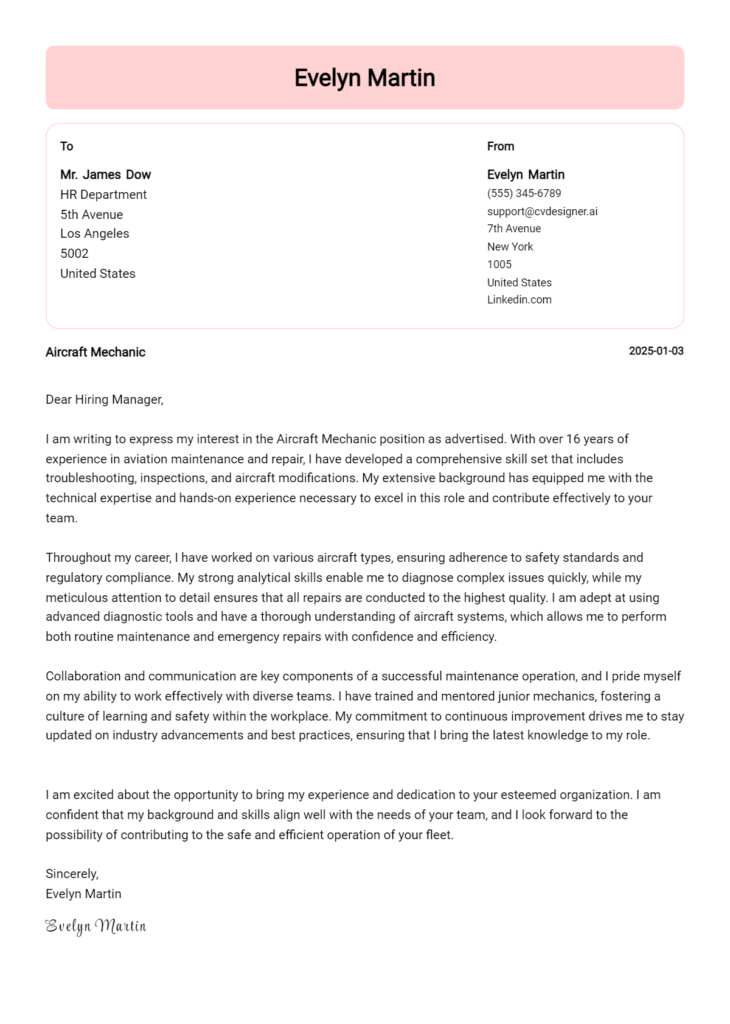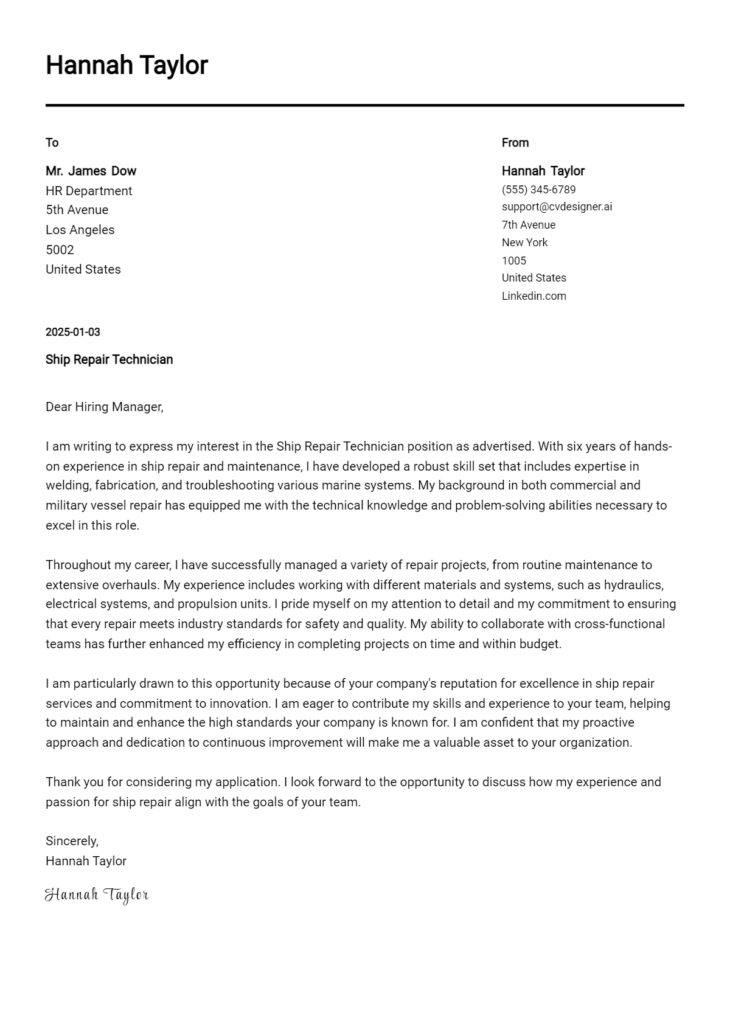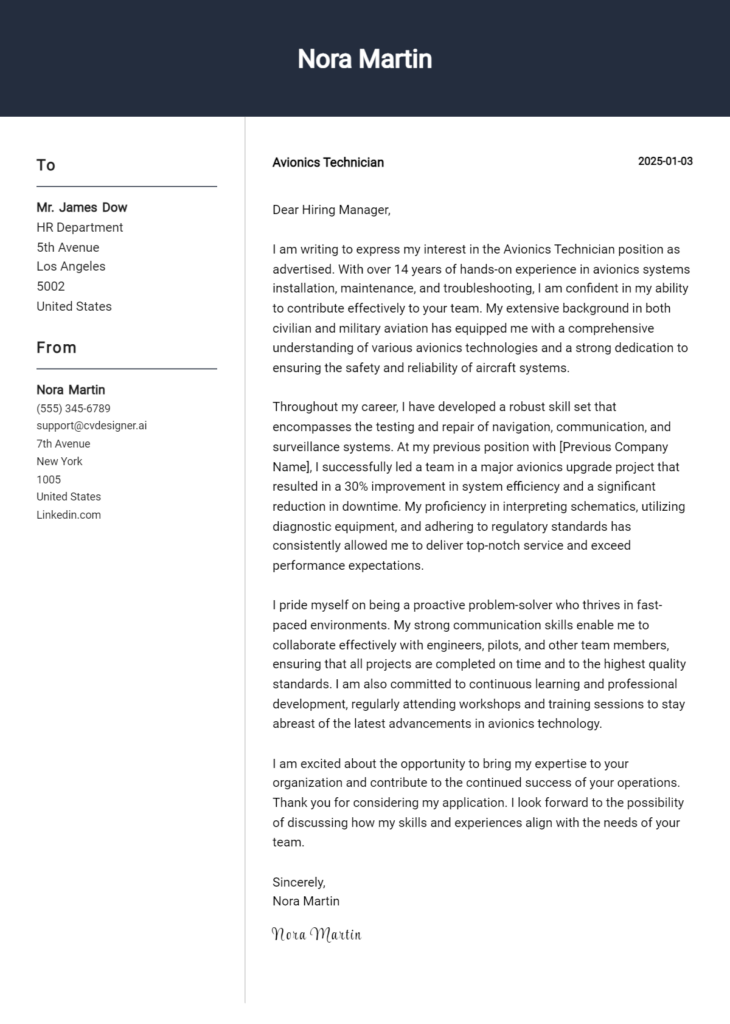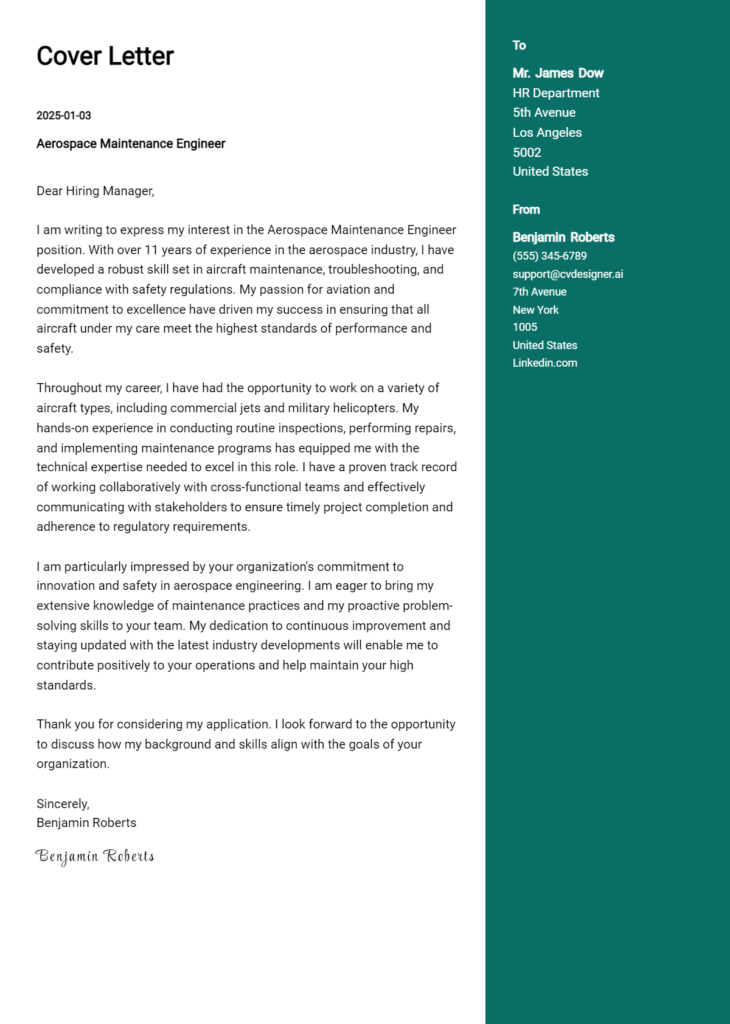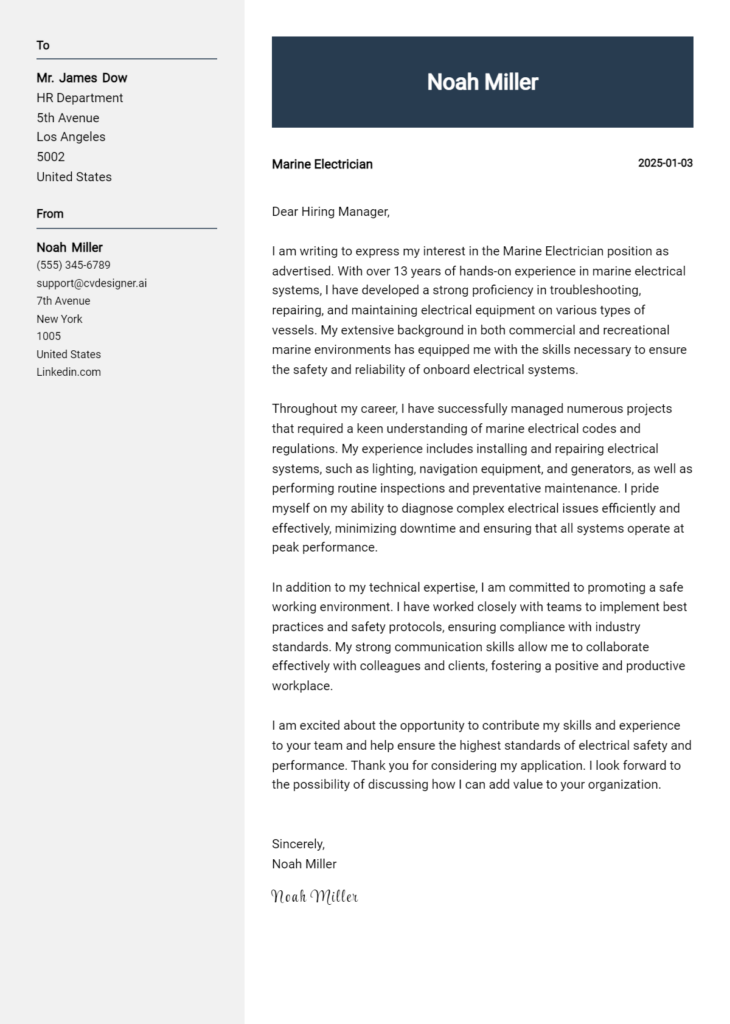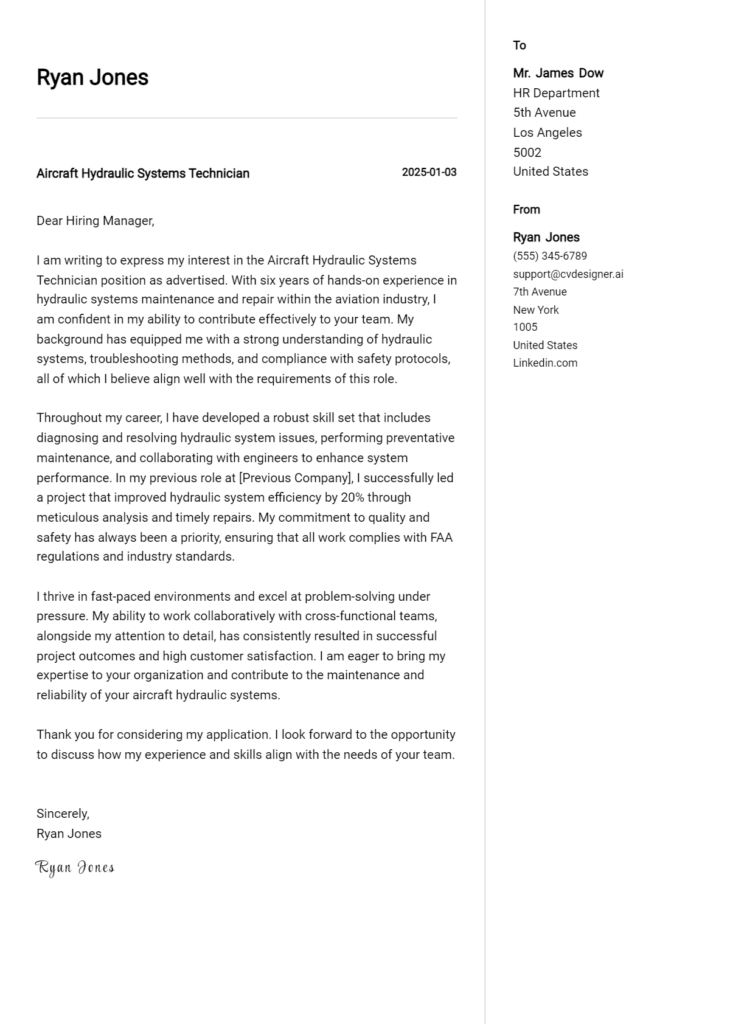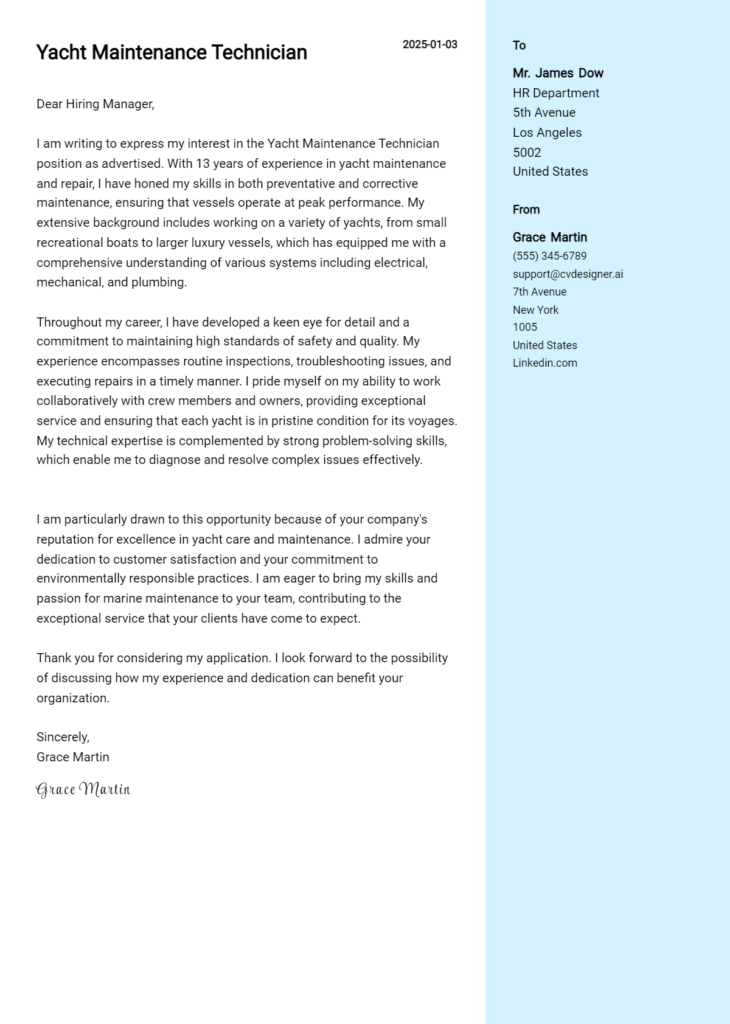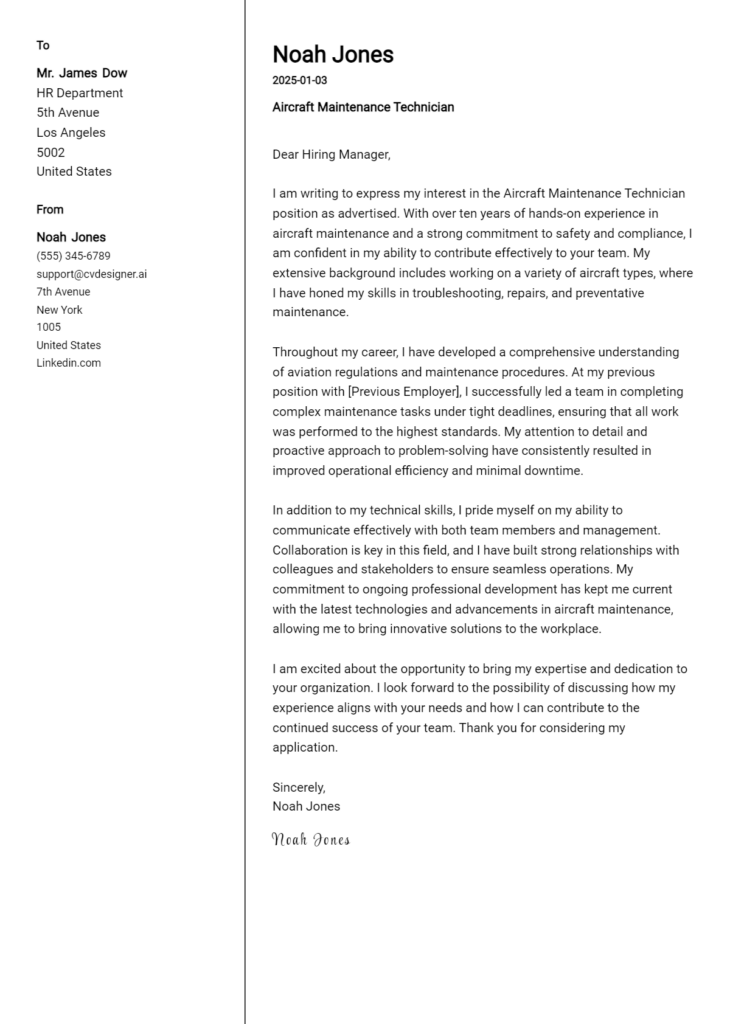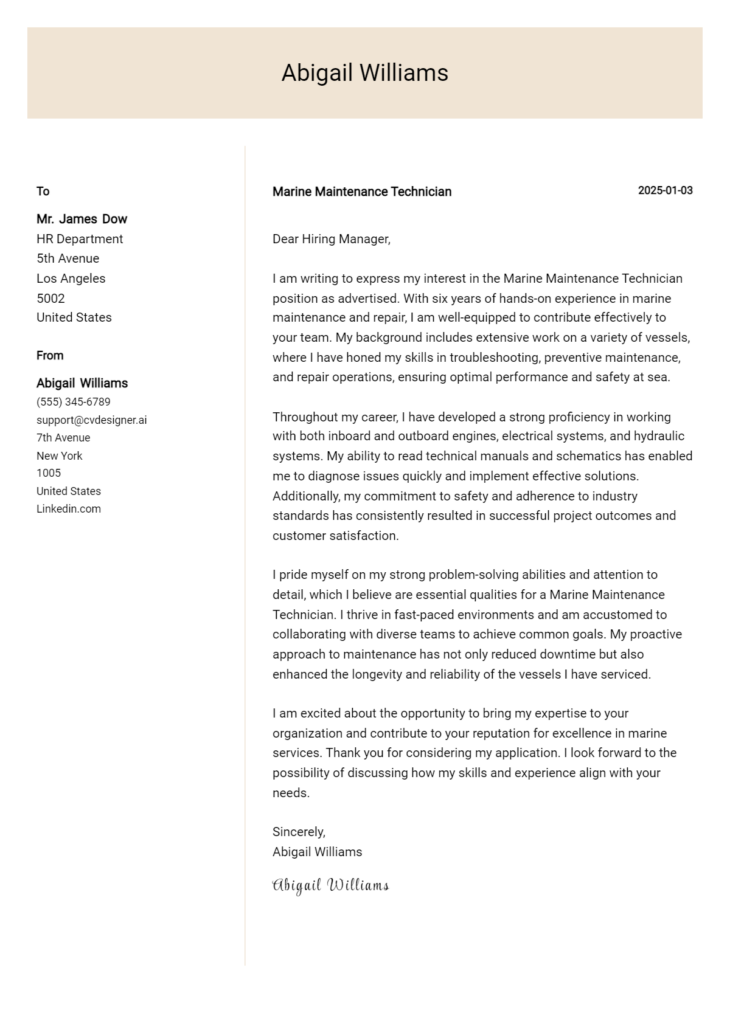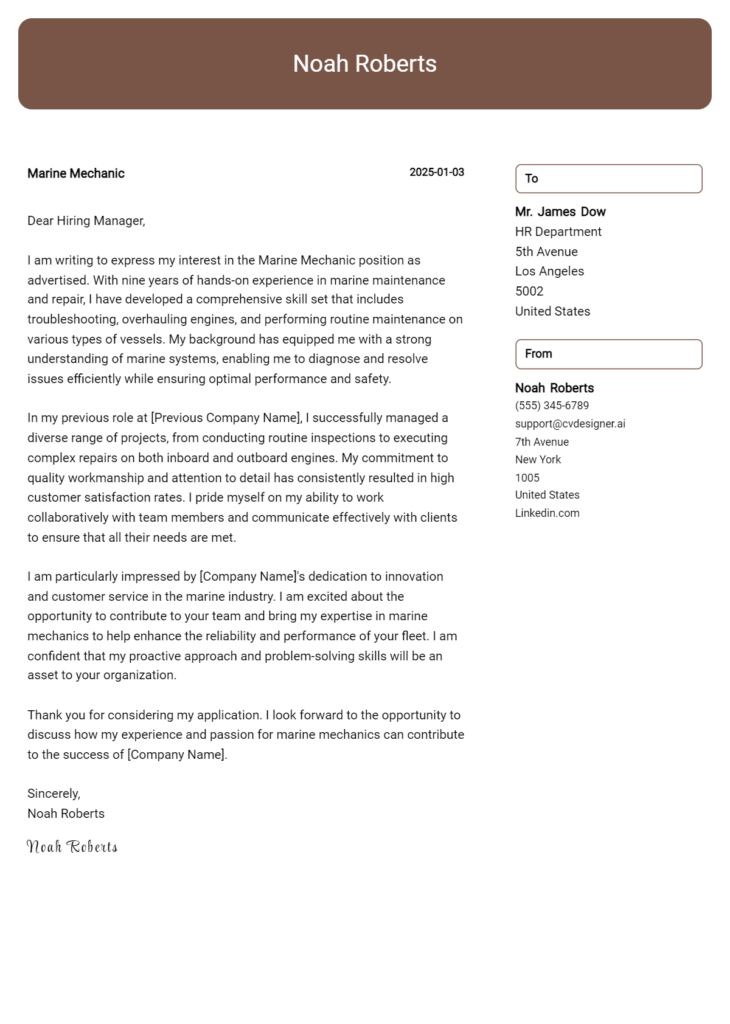Aircraft Propulsion Technician Cover Letter Examples
Explore additional Aircraft Propulsion Technician cover letter samples and guides and see what works for your level of experience or role.
How to Format an Aircraft Propulsion Technician Cover Letter?
Crafting a well-structured cover letter is essential for an Aircraft Propulsion Technician, as it not only highlights your technical skills but also emphasizes your ability to follow protocols and maintain precision—qualities that are paramount in the aviation industry. A meticulously formatted cover letter serves as your first impression, demonstrating your professionalism and attention to detail, which are critical in ensuring the safety and efficiency of aircraft operations.
In this guide, we will outline how to effectively structure your cover letter, providing insights and examples specific to the role of an Aircraft Propulsion Technician.
We will focus on the essential components of a professional cover letter, including:
- Cover Letter Header
- Cover Letter Greeting
- Cover Letter Introduction
- Cover Letter Body
- Cover Letter Closing
Each section is vital in showcasing your qualifications and suitability for the position. Let’s break down each part and explain how to make your Aircraft Propulsion Technician cover letter stand out.
The Importance of a Cover Letter Header for an Aircraft Propulsion Technician
The cover letter header is a crucial element of your application as an Aircraft Propulsion Technician. It sets the tone for your letter and provides essential information that allows the hiring manager to easily identify you and contact you. A professional header should include your contact information, the date, and the recipient's details. Clarity and professionalism in this section contribute to the overall impression you make, showcasing your attention to detail—an important trait in the aviation industry. Below are examples of a strong and weak cover letter header.
Strong Example
John Doe 123 Aviation Way Cityville, ST 12345 (555) 123-4567 johndoe@email.com October 1, 2023 Hiring Manager ABC Aerospace 456 Industry Rd Cityville, ST 12345
Weak Example
J. Doe 10/1/23 Manager Aerospace Co.
The Importance of a Strong Cover Letter Greeting for an Aircraft Propulsion Technician
The greeting of your cover letter serves as the first impression for your potential employer, setting the tone for the rest of your application. A well-crafted greeting not only demonstrates your professionalism but also adds a personal touch by addressing the hiring manager directly. This shows that you have taken the time to research the company and its employees, which can significantly enhance your candidacy. To avoid generic greetings that can make you appear disinterested, it's crucial to find the recipient's name. This level of personalization can create a positive connection right from the start.
Tips for a Strong Greeting:
- Address the hiring manager by name if possible.
- Use a formal salutation, such as "Dear" followed by the recipient's title and last name.
- Avoid generic greetings like "To Whom It May Concern."
Strong Greeting Example
Strong Greeting Example
Dear Mr. Johnson,
Weak Greeting Example
Weak Greeting Example
To Whom It May Concern,
By utilizing a strong greeting, you set a positive and professional tone for your cover letter, increasing your chances of making a favorable impression on the hiring manager.
The Importance of a Strong Cover Letter Introduction for an Aircraft Propulsion Technician
A well-crafted cover letter introduction is crucial for an Aircraft Propulsion Technician as it sets the tone for the rest of the application. This opening paragraph serves as the first impression for the hiring manager, making it essential to capture their attention while expressing genuine interest in the role. A strong introduction not only highlights the candidate's enthusiasm for the position but also succinctly showcases key skills or relevant achievements that align with the job requirements. Crafting an engaging introduction can significantly increase the chances of standing out in a competitive job market.
Strong Example
Dear Hiring Manager, I am excited to apply for the Aircraft Propulsion Technician position at [Company Name], as I have a deep passion for aviation and a proven track record in maintaining and troubleshooting advanced propulsion systems. With over five years of hands-on experience in a fast-paced maintenance environment, I have successfully reduced engine downtime by 20% through meticulous inspections and effective problem-solving strategies. I am eager to bring my expertise to your team and contribute to the high standards of safety and efficiency at [Company Name].
Weak Example
Hello, I saw that you are hiring for an Aircraft Propulsion Technician, and I thought I would apply. I have some experience in aviation maintenance, but I am not sure if I am the best fit. I hope you consider my application.
Purpose of the Cover Letter Body for an Aircraft Propulsion Technician
The body of a cover letter for an Aircraft Propulsion Technician serves as a critical opportunity for candidates to articulate their qualifications and demonstrate how their unique skills and experiences align with the needs of the company. This section should provide specific examples of previous projects, accomplishments, or technical proficiencies that underscore the candidate's ability to contribute positively to the organization's goals. By highlighting relevant achievements, such as successful engine overhauls, efficiency improvements, or safety enhancements, the candidate can effectively showcase their value and readiness to take on the responsibilities of the role.
Strong Example
Dear Hiring Manager, I am excited to apply for the Aircraft Propulsion Technician position at your esteemed organization. With over five years of experience in aircraft maintenance and propulsion systems, I have successfully led a project that improved engine efficiency by 15% through the implementation of a new diagnostic protocol. Furthermore, my role in overhauling the turbofan engines for the company’s fleet resulted in a 20% decrease in turnaround time, significantly enhancing operational availability. My technical expertise, combined with my commitment to safety and quality, makes me a strong candidate for this position. Sincerely, [Your Name]
Weak Example
Dear Hiring Manager, I am writing to express my interest in the Aircraft Propulsion Technician role. I have worked on various aircraft and have some experience with engines. I think I would be a good fit because I am a hard worker. I have repaired engines before, but I cannot recall any specific projects or accomplishments. I hope to bring my skills to your company. Best, [Your Name]
Importance of the Cover Letter Closing for an Aircraft Propulsion Technician
The closing paragraph of a cover letter is crucial as it encapsulates your qualifications, reinforces your enthusiasm for the position, and prompts the employer to take the next steps, such as reviewing your resume or scheduling an interview. A strong closing will leave a lasting impression and demonstrate your proactive attitude, while a weak one may fail to convey your suitability for the role or your eagerness to contribute to the team.
Strong Example
Thank you for considering my application for the Aircraft Propulsion Technician position. With my extensive training in aerospace systems and hands-on experience with turbine engines, I am excited about the possibility of contributing to your team at [Company Name]. I am eager to bring my technical skills and commitment to safety to your organization. I look forward to the opportunity to discuss how I can support your goals in a personal interview. Please feel free to contact me to arrange a meeting at your convenience. Thank you once again for your time and consideration.
Weak Example
Thanks for reading my letter. I hope you look at my resume. I think I might be a good fit for the job. Let me know if you want to talk.
Crafting an effective cover letter for an Aircraft Propulsion Technician position is crucial in showcasing your qualifications and fit for the role. A well-written cover letter not only highlights your technical skills and problem-solving abilities but also reflects your understanding of the software development lifecycle (SDLC), teamwork dynamics, and your commitment to continuous learning. Here are some tips to help you create a compelling cover letter that stands out to potential employers.
Tips for Writing an Effective Cover Letter
Emphasize Technical Skills: Start your cover letter by highlighting your technical expertise in aircraft propulsion systems. Discuss specific skills such as engine maintenance, troubleshooting techniques, and familiarity with diagnostic tools. Tailor your examples to align with the job description to demonstrate that you possess the relevant competencies.
Showcase Problem-Solving Abilities: In the aviation industry, the ability to troubleshoot and resolve issues efficiently is vital. Include specific instances where you successfully diagnosed and fixed propulsion-related problems. This not only shows your hands-on experience but also your analytical thinking and resourcefulness in challenging situations.
Demonstrate SDLC Knowledge: Mention your familiarity with the software development lifecycle, especially if your role involves working with integrated systems. This can include understanding how software affects propulsion systems and your ability to collaborate with software engineers to enhance system performance.
Highlight Teamwork and Collaboration: Aircraft Propulsion Technicians often work as part of a team. Share examples of how you have effectively collaborated with engineers, other technicians, and stakeholders on projects. This not only illustrates your interpersonal skills but also your ability to contribute to a positive working environment.
Express a Passion for Continuous Learning: The aviation field is constantly evolving, and your commitment to ongoing education and skill development is essential. Discuss any additional certifications, training, or workshops you have pursued to stay current with industry advancements. This shows potential employers that you are proactive and dedicated to your professional growth.
By incorporating these tips into your cover letter, you can effectively convey your qualifications and enthusiasm for the Aircraft Propulsion Technician role. For further assistance, consider using cover letter templates or a cover letter builder to help structure your content efficiently.
Common Mistakes to Avoid in a Aircraft Propulsion Technician Cover Letter
Crafting an effective cover letter is essential for standing out in the competitive field of aircraft propulsion technology. Avoiding common mistakes can significantly enhance your chances of securing an interview. Here are some pitfalls to watch out for:
Generic Greetings: Using "To Whom It May Concern" can make your letter feel impersonal. Instead, research the hiring manager's name for a more personalized touch.
Lack of Specificity: Failing to mention specific skills or experiences relevant to the Aircraft Propulsion Technician role may weaken your application. Tailor your letter to highlight your specific qualifications and experiences.
Ignoring Formatting Guidelines: Neglecting proper cover letter format can make your letter difficult to read. Use clear headings, a professional font, and appropriate spacing to enhance readability.
Repetition of the Resume: Simply restating your resume in your cover letter is redundant. Instead, use the cover letter to elaborate on key achievements and how they relate to the job.
Poor Grammar and Spelling: Typos and grammatical errors can create an unprofessional impression. Always proofread your letter and consider using tools or asking a friend for feedback.
Lack of Enthusiasm: Failing to convey genuine interest in the position can make your application seem lackluster. Express your passion for the field and the specific company to make a strong impression.
Neglecting to Include a Call to Action: A strong closing without a call to action can leave the hiring manager uncertain about your intentions. Politely express your desire for an interview and thank them for considering your application.
By steering clear of these common mistakes, you can create a compelling cover letter that effectively showcases your skills and passion for the role. For further inspiration, check out these cover letter examples to help you craft your own unique letter.
Cover Letter FAQs for Aircraft Propulsion Technician
What should I include in my cover letter for an Aircraft Propulsion Technician position?
When crafting your cover letter, you should include your relevant experience, technical skills, and certifications that pertain to aircraft propulsion systems. Start with a strong introduction that states your intent and expresses enthusiasm for the role. Highlight specific experiences that demonstrate your proficiency in troubleshooting, maintenance, and repair of propulsion systems. Additionally, mention any certifications you hold, such as A&P (Airframe and Powerplant) certification, which can enhance your credibility. Conclude with a call to action, inviting the employer to discuss your qualifications further in an interview.
How can I tailor my cover letter for a specific job application?
To tailor your cover letter, closely read the job description and identify key skills and experiences the employer is seeking. Use specific language from the job posting in your cover letter to demonstrate alignment with the company’s needs. If the position emphasizes experience with a particular engine type or troubleshooting techniques, ensure you mention your relevant experience with those systems. Personalizing your cover letter shows the employer that you are genuinely interested in the position and have taken the time to understand their requirements.
Should I include technical jargon in my cover letter?
Yes, incorporating relevant technical jargon can be beneficial in your cover letter, as it demonstrates your familiarity with the field and your expertise as an Aircraft Propulsion Technician. However, ensure that the jargon used is appropriate and understandable for the reader. Avoid overly complex terminology that could confuse the hiring manager. Striking a balance between technical language and clear communication can showcase your qualifications while remaining accessible. Aim to explain any technical terms briefly if they are crucial to your points, making sure to maintain clarity throughout.
How can I effectively demonstrate my passion for aviation in my cover letter?
To demonstrate your passion for aviation, share personal anecdotes or experiences that illustrate your long-standing interest in the field. Discuss any relevant projects you've worked on, such as internships, personal aircraft restoration, or participation in aviation clubs. Mention any industry-related events you've attended or certifications you've pursued beyond basic requirements. Conveying your enthusiasm through specific examples can make a strong impression. Additionally, express why you are drawn to the company you are applying to, emphasizing how their mission resonates with your passion for aviation and propulsion technology.
Build your Cover Letter in minutes
Use an AI-powered cover letter builder and have your letter done in 5 minutes. Just select your template and our software will guide you through the process.

